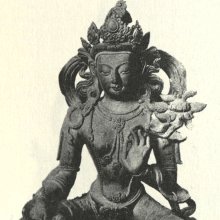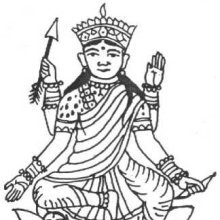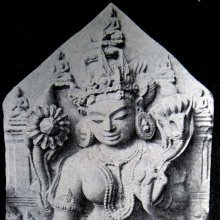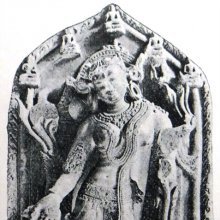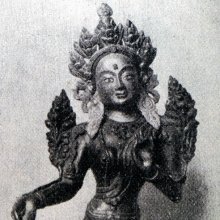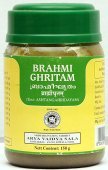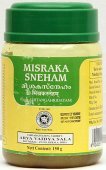Shyama, Śyāmā, Śyāma: 43 definitions
Introduction:
Shyama means something in Buddhism, Pali, Hinduism, Sanskrit, Jainism, Prakrit, Marathi, Hindi, biology. If you want to know the exact meaning, history, etymology or English translation of this term then check out the descriptions on this page. Add your comment or reference to a book if you want to contribute to this summary article.
The Sanskrit terms Śyāmā and Śyāma can be transliterated into English as Syama or Shyama, using the IAST transliteration scheme (?).
Images (photo gallery)
In Hinduism
Shaivism (Shaiva philosophy)
Source: Wisdom Library: Ṣaṭsāhasra-saṃhitāŚyāmā (श्यामा):—One of the twelve guṇas associated with Kāma, the second seat of the Svādhiṣṭhāna-chakra. According to tantric sources such as the Śrīmatottara-tantra and the Gorakṣasaṃhitā (Kādiprakaraṇa), these twelve guṇas are represented as female deities. According to the Ṣaṭsāhasrasaṃhitā however, they are explained as particular syllables. They (e.g. Śyāmā) only seem to play an minor role with regard to the interpretation of the Devīcakra (first of five chakras, as taught in the Kubjikāmata-tantra).

Shaiva (शैव, śaiva) or Shaivism (śaivism) represents a tradition of Hinduism worshiping Shiva as the supreme being. Closely related to Shaktism, Shaiva literature includes a range of scriptures, including Tantras, while the root of this tradition may be traced back to the ancient Vedas.
Ayurveda (science of life)
Cikitsa (natural therapy and treatment for medical conditions)
Source: Wisdom Library: Ayurveda: Cikitsa1) Śyāmā (श्यामा, “black”):—Another name for Trivṛt (Operculina turpethum), a species of medicinal plant and used in the treatment of fever (jvara), as described in the Jvaracikitsā (or “the treatment of fever”) which is part of the 7th-century Mādhavacikitsā, a Sanskrit classical work on Āyurveda.
2) Śyāma (श्याम) is a synonym for Priyaṅgu, which is a Sanskrit name for a medicinal plant (Callicarpa macrophylla). It can also be spelled as Śyāmā (श्यामा). It is a technical term used throughout Ayurvedic literature such as the Caraka-saṃhitā and the Suśruta-saṃhitā. This synonym was identified by Amarasiṃha in his Amarakośa (a Sanskrit botanical thesaurus from the 4th century). It is also mentioned as a synonym in the Bhāvaprakāśa-nighaṇṭu (medicinal thesareus) authored by Bhāvamiśra 16th century.
Nighantu (Synonyms and Characteristics of Drugs and technical terms)
Source: Wisdom Library: Raj NighantuŚyāmā (श्यामा) refers to “earth” and is mentioned in a list of 53 synonyms for dharaṇi (“earth”), according to the second chapter (dharaṇyādi-varga) of the 13th-century Raj Nighantu or Rājanighaṇṭu (an Ayurvedic encyclopedia). The Dharaṇyādi-varga covers the lands, soil [viz., Śyāmā], mountains, jungles and vegetation’s relations between trees and plants and substances, with their various kinds.
Source: WorldCat: Rāj nighaṇṭu1) Śyāmā (श्यामा) is another name for Guḍūcī, a medicinal plant identified with Tinospora cordifolia (heart-leaved moonseed) from the Menispermaceae or “moonseed family” of flowering plants, according to verse 3.13-16 of the 13th-century Raj Nighantu or Rājanighaṇṭu. The third chapter (guḍūcyādi-varga) of this book contains climbers and creepers (vīrudh). Together with the names Śyāmā and Guḍūcī, there are a total of thirty Sanskrit synonyms identified for this plant.
2) Śyāmā (श्यामा) is also mentioned as a synonym for Nīlī, a medicinal plant possibly identified with Indigofera tinctoria Linn. (“true indigo”), according to verse 4.80-83. The fourth chapter (śatāhvādi-varga) of this book enumerates eighty varieties of small plants (pṛthu-kṣupa). Together with the names Śyāmā and Nīlī, there are a total of thirty Sanskrit synonyms identified for this plant.
3) Śyāmā (श्यामा) is also mentioned as a synonym for Vaṭapatrī, an unidentified medicinal plant, according to verse 5.41-42. The fifth chapter (parpaṭādi-varga) of this book enumerates sixty varieties of smaller plants (kṣudra-kṣupa). Together with the names Śyāmā and Vaṭapatrī, there are a total of five Sanskrit synonyms identified for this plant.
4) Śyāmā (श्यामा) is also mentioned as a synonym for Vandāka, a medicinal plant identified with two possibly species verse, according to verse 5.68-70. Together with the names Śyāmā and Vandāka, there are a total of sixteen Sanskrit synonyms identified for this plant. Note: Nāḍkarṇī identifies Vandāka with 1) Vanda roxburghii R. Br. while Th. B.S. et al identifies it with 2) Loranthus longiflorus Desr. of.
5) Śyāmā (श्यामा) is also mentioned as a synonym for Nīlapunarnavā, a medicinal plant identified with Trianthema portulacastrum Linn. or “desert horsepurslane” from the Aizoaceae or “fig-marigold” family of flowering plants, according to verse 5.115-122. Together with the names Śyāmā and Nīlapunarnavā, there are a total of seven Sanskrit synonyms identified for this plant.
6) Śyāmā (श्यामा) is another name for Pippalī, a medicinal plant identified with Piper longum Linn. or “Indian long pepper” from the Piperaceae or ‘pepper’ family of flowering plants, according to verse 6.11-13. The sixth chapter (pippalyādi-varga) of this book enumerates ninety-five varieties of plants obtained from the market (paṇyauṣadhi). Together with the names Śyāmā and Pippalī, there are a total of nineteen Sanskrit synonyms identified for this plant.
7) Śyāma (श्याम) is another name for Marica, a medicinal plant identified with Piper nigrum Linn. or “black pepper” from the Piperaceae or “pepper” family of flowering plants, according to verse 6.30-32. Together with the names Śyāma and Marica, there are a total of seventeen Sanskrit synonyms identified for this plant.
Kalpa (Formulas, Drug prescriptions and other Medicinal preparations)
Source: Shodhganga: Edition translation and critical study of yogasarasamgrahaŚyāmā (श्यामा) refers to the medicinal plant known as “Operculina turpethum (Linn.) Silva Manso (black)” and is dealt with in the 15th-century Yogasārasaṅgraha (Yogasara-saṅgraha) by Vāsudeva: an unpublished Keralite work representing an Ayurvedic compendium of medicinal recipes. The Yogasārasaṃgraha [mentioning śyāmā] deals with entire recipes in the route of administration, and thus deals with the knowledge of pharmacy (bhaiṣajya-kalpanā) which is a branch of pharmacology (dravyaguṇa).

Āyurveda (आयुर्वेद, ayurveda) is a branch of Indian science dealing with medicine, herbalism, taxology, anatomy, surgery, alchemy and related topics. Traditional practice of Āyurveda in ancient India dates back to at least the first millenium BC. Literature is commonly written in Sanskrit using various poetic metres.
Purana and Itihasa (epic history)
Source: Wisdom Library: The Matsya-purāṇaŚyāmā (श्यामा) is the name of a mind-born ‘divine mother’ (mātṛ), created for the purpose of drinking the blood of the Andhaka demons, according to the Matsya-purāṇa 179.8. The Andhaka demons spawned out of every drop of blood spilled from the original Andhakāsura (Andhaka-demon). According to the Matsya-purāṇa 179.35, “Most terrible they (e.g., Śyāmā) all drank the blood of those Andhakas and become exceedingly satiated.”
The Matsyapurāṇa is categorised as a Mahāpurāṇa, and was originally composed of 20,000 metrical verses, dating from the 1st-millennium BCE. The narrator is Matsya, one of the ten major avatars of Viṣṇu.
Source: Wisdom Library: Varāha-purāṇaŚyāmā (श्यामा).—Name of a river (nadī) situated near the seven great mountains on the western side of mount Naiṣadha, according to the Varāhapurāṇa chapter 83. These settlements consume the water flowing from these seven great mountains (Viśākha, Kambala, Jayanta, Kṛṣṇa, Harita, Aśoka and Vardhamāna). Niṣadha (Naiṣadha) is one of the seven mountains located in Jambūdvīpa, ruled over by Āgnīdhra, a grandson of Svāyambhuva Manu, who was created by Brahmā, who was in turn created by Nārāyaṇa, the unknowable all-pervasive primordial being.
Source: archive.org: Puranic Encyclopedia1) Śyāmā (श्यामा).—One of the nine daughters of Meru, including Śyāmā. They are called Navakanyās. They were married by the sons of Agnīdhra. (Bhāgavata, 5th Skandha).
2) Śyāma (श्याम).—A mountain in Śākadvīpa. It is as dark as clouds and very tall. (Mahābhārata Bhīṣma Parva, Chapter 11, Verse 19).
Source: archive.org: Nilamata Purana: a cultural and literary studyŚyāmā (श्यामा) refers to a deity (Goddess) representing a “personified vine-creeper”, whose festival was once celebrated in ancient Kashmir (Kaśmīra) as mentioned in the Nīlamatapurāṇa (verse 797ff).—These Goddesses (e.g., Śyāmā) form the shining galaxy of female deities worshipped by the people of Kaśmīra.
Source: Cologne Digital Sanskrit Dictionaries: The Purana Index1a) Śyāma (श्याम).—Mt. a hill of the Śākadvīpa; here people are of Śyāma colour.*
- * Brahmāṇḍa-purāṇa II. 19. 88; Matsya-purāṇa 122. 12; Vāyu-purāṇa 49. 82; Viṣṇu-purāṇa II. 4. 62.
1b) A son of Sarama.*
- * Brahmāṇḍa-purāṇa III. 7. 312.
1c) A son of Śūra and Bhojā; had no son.*
- * Brahmāṇḍa-purāṇa III. 71. 150, 194; Matsya-purāṇa 46. 3.
1d) A son of Śamika; had no issue;1 adopted as son the son of Vastāvana; went to the forest; became Bhoja and a Rājaṛṣi.2
1e) A brother of Vasudeva.*
- * Vāyu-purāṇa 96. 148 Viṣṇu-purāṇa IV. 14. 30.
1f) One of the two dogs of the family of Vaivasvata to whom bali is to be offered in yajña.*
- * Vāyu-purāṇa 108. 30; 111. 39.
1g) Sons of Kallolaha.*
- * Brahmāṇḍa-purāṇa III. 7. 442.
1h) Belonging to the Dattātreya gotra.*
- * Vāyu-purāṇa 70. 77.
1i) A Parāśara branch.*
- * Vāyu-purāṇa 70. 87.
2a) Śyāmā (श्यामा).—A daughter of Meru and wife of Hiraṇmaya.*
- * Bhāgavata-purāṇa V. 2. 23.
2b) A name of Lalitā; appeared before the sage Mātaṅga and agreed to be his daughter. Hence Mātaṅgī.*
- * Brahmāṇḍa-purāṇa IV. 17. 83; 28. 37; 31. 84, 93.
2c) A mind-born mother.*
- * Matsya-purāṇa 179. 17.
2d) A R. of the Ketumālā continent.*
- * Vāyu-purāṇa 44. 17.

The Purana (पुराण, purāṇas) refers to Sanskrit literature preserving ancient India’s vast cultural history, including historical legends, religious ceremonies, various arts and sciences. The eighteen mahapuranas total over 400,000 shlokas (metrical couplets) and date to at least several centuries BCE.
Natyashastra (theatrics and dramaturgy)
Source: Wisdom Library: Nāṭya-śāstra1) Śyāma (श्याम, “dark”) refers to a specific “color of the face” which form part of the histrionic representation (abhinaya), according to the Nāṭyaśāstra chapter 8. According to its instructions, this facial color should be use when “in the Terrible (bhayānaka) and the Odious (bībhatsa) Sentiments (rasa)”.
2) Śyāma (श्याम, “dark-blue”) refers to a color, according to Nāṭyaśāstra chapter 23. It is also known by the name Asita. According to the science of āhāryābhinaya (extraneous representation), there are four main colors (varṇa) from which various derivative and minor colors (upavarṇa) are derived. Colors are used in aṅgaracanā (painting the limbs), which forms a section of nepathya (costumes and make-up).
According to the Nāṭyaśāstra, “Nārāyaṇa and Nara as well as Vāsuki should be dark blue (śyāma)”.
Source: Shodhganga: Elements of Art and Architecture in the Trtiyakhanda of the Visnudharmottarapurana (natya)Śyāma (श्याम) or “dark-blue (colour)” is associated with Śṛṅgāra or the “erotic sentiment”, which represents one of the nine kinds of Rasa (“soul of Drama”), according to the Viṣṇudharmottarapurāṇa, an ancient Sanskrit text which (being encyclopedic in nature) deals with a variety of cultural topics such as arts, architecture, music, grammar and astronomy.—Śṛṇgāra-rasa is the sentiment of love and desire where the manifestation of the activities of Kāmadeva i.e the god of love can be noticed. Rati i.e erotic emotion is the sthāyībhāva or permanent feeling of śṛṇgāra. Śyāma i.e dark blue is the colour of this sentiment. Viṣṇu is the God of this sentiment.

Natyashastra (नाट्यशास्त्र, nāṭyaśāstra) refers to both the ancient Indian tradition (shastra) of performing arts, (natya—theatrics, drama, dance, music), as well as the name of a Sanskrit work dealing with these subjects. It also teaches the rules for composing Dramatic plays (nataka), construction and performance of Theater, and Poetic works (kavya).
Shaktism (Shakta philosophy)
Source: Google Books: ManthanabhairavatantramŚyāmā (श्यामा) refers to “dark-blue”, and is used to describe the Goddess, according to the Śrīmatottara-tantra, an expansion of the Kubjikāmatatantra: the earliest popular and most authoritative Tantra of the Kubjikā cult.—Accordingly, “[...] When she heard the Bhairavīstotra, that Kuleśvarī burst apart the Liṅga by means of Bhairava’s unlimited energy (tejas) and having done so, emerged out (of it). She was dark blue (śyāmā) like the petals of a blue lotus and (her hair was) tied up in the barbarian style. Extending her left hand, she was bent over (kubjarūpā) and had a big belly. The goddess with a fierce (karāla) face, (her) mind full of wonder, spoke there in (that) dwelling (vāsara), looking around in all directions”.
Source: Kamakoti Mandali: The Yoginis of Narasimha VyuhaŚyāmā (श्यामा) is the name of a Mātṛkā-Śakti created by Mahārudra in order to control the plague of demons created by Andhakāsura.—Accordingly, Andhaka-Asura tried to kidnap Umā (Devī Pārvatī), and was fiercely attacked by Mahārudra who shot arrows at him from his mahāpināka. when the arrows pierced the body of Andhakāsura, drops of blood fell to earth and from those drops, thousands of Andhakas arose. To control this plague of demons, Mahārudra created Mātṛkā-Śaktis [viz., Śyāmā] and ordered them to drink the blood of the demons and drain them dry.
Source: Kamakoti Mandali: Nrisimha matrika-mandalaŚyāmā (श्यामा) refers to one of the various Mātṛkā-Śaktis created by Rudra in order to destroy the clones that spawned from Andhaka’s body.—Accordingly, [...] Andhakāsura attempted to abduct Girājanandinī (Pārvatī) and thus ensued a fierce battle between Andhakāsura and the great Rudra, the Lord of Umā. Like raktabīja, every drop of blood that fell from the body of Andhaka created another Asura like him and in no time, the entire world was filled with Andhakas. To destroy the growing number of Andhakas, Rudra created innumerable Mātṛkā-Śaktis [viz., Śyāmā]. These Śaktis of immense power at once began to drink every drop of blood that flowed from the body of Andhaka, but they could still not effectively contain the emergence of more and more demons.

Shakta (शाक्त, śākta) or Shaktism (śāktism) represents a tradition of Hinduism where the Goddess (Devi) is revered and worshipped. Shakta literature includes a range of scriptures, including various Agamas and Tantras, although its roots may be traced back to the Vedas.
Chandas (prosody, study of Sanskrit metres)
Source: Journal of the University of Bombay Volume V: Apabhramsa metres (2)Śyāmā (श्यामा) is related to Vigalitā, which refers to a catuṣpadi metre (as popularly employed by the Apabhraṃśa bards), as discussed in books such as the Chandonuśāsana, Kavidarpaṇa, Vṛttajātisamuccaya and Svayambhūchandas.—Vigalitā has 23 mātrās in each of its four lines, divided into the groups of 5, 5, 4, 4 and 5 mātrās.—Vigalitā is also called Śyāmā when its last pañcamātra is of the [ISS] type.
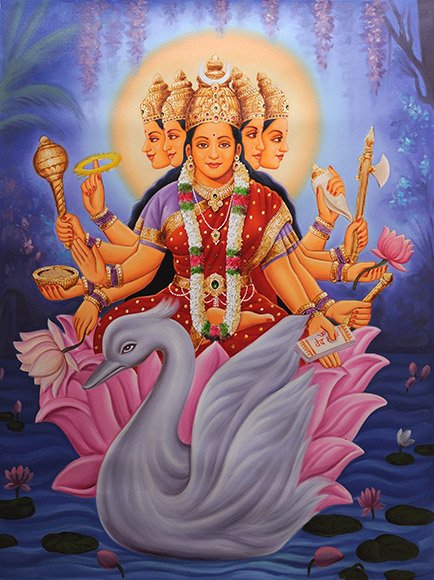
Chandas (छन्दस्) refers to Sanskrit prosody and represents one of the six Vedangas (auxiliary disciplines belonging to the study of the Vedas). The science of prosody (chandas-shastra) focusses on the study of the poetic meters such as the commonly known twenty-six metres mentioned by Pingalas.
Vaishnavism (Vaishava dharma)
Source: Pure Bhakti: Brhad BhagavatamrtamŚyāma (श्याम) refers to:—Transcendental dark color; the color of a dark raincloud, sapphire, or blue lotus; a name for Śrī Kṛṣṇa. (cf. Glossary page from Śrī Bṛhad-bhāgavatāmṛta).

Vaishnava (वैष्णव, vaiṣṇava) or vaishnavism (vaiṣṇavism) represents a tradition of Hinduism worshipping Vishnu as the supreme Lord. Similar to the Shaktism and Shaivism traditions, Vaishnavism also developed as an individual movement, famous for its exposition of the dashavatara (‘ten avatars of Vishnu’).
Jyotisha (astronomy and astrology)
Source: Wisdom Library: Brihat Samhita by VarahamihiraŚyāma (श्याम) refers to a “black-colored sun”, according to the Bṛhatsaṃhitā (chapter 3), an encyclopedic Sanskrit work written by Varāhamihira mainly focusing on the science of ancient Indian astronomy astronomy (Jyotiṣa).—Accordingly, “If in Varṣā the colour of the sun be that of the flower Śirīṣa (Mimosa flexuosa) there will be immediate rain; if the colour be that of the peacock’s plume there will be no rain for twelve years to come. If, then the sun be black [i.e., śyāma] there will be fear from worms and reptiles; if it be ashy pale there will be fear from foreign princes; if the sun should appear with a hole that prince will perish in the star of whose nativity the sun then happens to be”.

Jyotisha (ज्योतिष, jyotiṣa or jyotish) refers to ‘astronomy’ or “Vedic astrology” and represents the fifth of the six Vedangas (additional sciences to be studied along with the Vedas). Jyotisha concerns itself with the study and prediction of the movements of celestial bodies, in order to calculate the auspicious time for rituals and ceremonies.
Shilpashastra (iconography)
Source: Shodhganga: Elements of Art and Architecture in the Trtiyakhanda of the Visnudharmottarapurana (shilpa)Śyāma (श्याम) refers to a “dark complexion” and is associated with Messengers, which follows specific guidelines in the tradition of ancient Indian Painting (citra), according to the Viṣṇudharmottarapurāṇa, an ancient Sanskrit text which (being encyclopedic in nature) deals with a variety of cultural topics such as arts, architecture, music, grammar and astronomy.—The body complexion of an elephant rider and a messenger should be śyāma i.e., dark and kapila i.e., tawny in a picture respectively. Thus the Viṣṇudharmottarapurāṇa establishes the fact that even in the pictures; the people belonging to different class and profession [e.g., messengers with a śyāma-complexion] were projected with specific attire so that general people can equate the picture with the practical character.
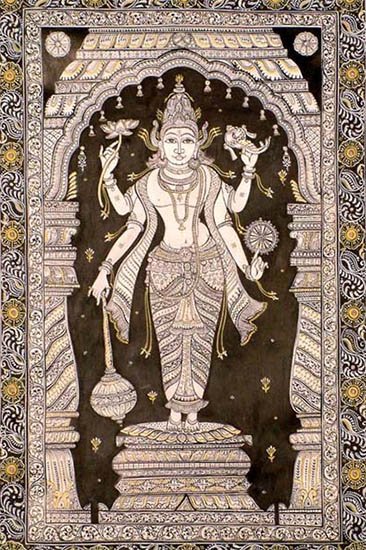
Shilpashastra (शिल्पशास्त्र, śilpaśāstra) represents the ancient Indian science (shastra) of creative arts (shilpa) such as sculpture, iconography and painting. Closely related to Vastushastra (architecture), they often share the same literature.
General definition (in Hinduism)
Source: archive.org: Vedic index of Names and SubjectsŚyāma (श्याम, ‘swarthy’) with Ayas (‘metal’) in all probability denotes ‘iron’ in the Atharvaveda. Śyāma alone has the same sense in the Atharvaveda and later.
In Buddhism
Tibetan Buddhism (Vajrayana or tantric Buddhism)
Source: Wisdomlib Libary: VajrayoginiŚyāmā (श्यामा) is the goddess presiding over one of the six petals of the western lotus of the vārāhyabhyudaya-maṇḍala, according to the Vārāhyabhyudayatantra (largerly extracted from the 10th century Abhidhānottaratantra). She is also known as Śyāmādevī. These six petals are presided over by a kuleśvarī (presiding lady) named Tārā. The central deity of the vārāhyabhyudaya-maṇḍala is the twelve-armed Vajravarāhī.
Śyāmā is associated with the sacred site (pīṭha) named Kaliṅga. All the goddess of the western lotus petals are to be visualised as dancing naked and being half-male / half-female (ardhanarīśvarī) with their two sides being red and yellow. In their four arms they brandish a bowl and staff, with a ḍamaru and their familial attribute.
Source: OSU Press: Cakrasamvara SamadhiŚyāma (श्याम) refers to “dark green”, according to the Cakrasaṃvara Samādhi [i.e., Cakrasamvara Meditation] ritual often performed in combination with the Cakrasaṃvara Samādhi, which refers to the primary pūjā and sādhanā practice of Newah Mahāyāna-Vajrayāna Buddhists in Nepal.—Accordingly, “Beginning with the East, dark blue, dark green (śyāma), red and yelow, Kākāsyā, Ulūkāsyā, Śvānāsyā, Śūkarāsyā, Yamadāhī, Yamadūtī, Yamadaṃṣṭrī, Yamamathanī, vajra-arise, vajra-bind Hūṃ!”.
Source: academia.edu: The Structure and Meanings of the Heruka MaṇḍalaŚyāmā (श्यामा) (or Sāmā) is the name of a Ḍākinī who, together with the Vīra (hero) named Sāma forms one of the 36 pairs situated in the Vāyucakra, according to the 10th century Ḍākārṇava chapter 15. Accordingly, the vāyucakra refers to one of the three divisions of the dharma-puṭa (‘dharma layer’), situated in the Herukamaṇḍala. The 36 pairs of Ḍākinīs [viz., Sāmā] and Vīras are dark blue in color; they each have one face and four arms; they hold a skull bowl, a skull staff, a small drum, and a knife.

Tibetan Buddhism includes schools such as Nyingma, Kadampa, Kagyu and Gelug. Their primary canon of literature is divided in two broad categories: The Kangyur, which consists of Buddha’s words, and the Tengyur, which includes commentaries from various sources. Esotericism and tantra techniques (vajrayāna) are collected indepently.
Mahayana (major branch of Buddhism)
Source: Wisdom Library: Maha Prajnaparamita SastraŚyāma (श्याम) refers to one of the dogs part of the four utsadas of the Avīci hell according to the “world of transmigration” section in the 2nd century Mahāprajñāpāramitāśāstra (chapter XXVII).—Accordingly, “two evil dogs, Che mo (Śyāma) and Che p’o lo (Śabala), fierce beasts with iron gullets, tear at the sinews and bones of these damned. These dogs are as strong as tigers and as fierce as lions”.

Mahayana (महायान, mahāyāna) is a major branch of Buddhism focusing on the path of a Bodhisattva (spiritual aspirants/ enlightened beings). Extant literature is vast and primarely composed in the Sanskrit language. There are many sūtras of which some of the earliest are the various Prajñāpāramitā sūtras.
In Jainism
General definition (in Jainism)
Source: Wisdom Library: JainismŚyāmā (श्यामा) is the mother of Vimala according to Śvetāmbara (but she is named Jayaśyāmā according to Digambara), according to the Ācāradinakara (14th century work on Jain conduct written by Vardhamāna Sūri). Vimala is the thirteenth of twenty-four Tīrthaṅkaras in Janism. A Tīrthaṅkara is an enlightened being who has conquered saṃsāra (cycle of birth and death), leaving behind him a path for others to follow.
The husband of Śyāmā is Kṛtavarmā. It is an ancient Jain practice to worship the Tīrthaṅkara’s parents in various rites, such as the pratiṣṭhāvidhi.
Source: archive.org: The Jaina IconographyŚyāmā (श्यामा) (or Manovegā, Acyutā) is the name of the Yakṣiṇī accompanying Padmaprabha: the sixth of twenty-four Tīrthaṃkaras or Jinas, commonly depicted in Jaina iconography.—The books of Jainism assign to the sixth Tīrthaṃkara Padmaprabha the cihna or iconographic cognizance of a red lotus. His Kevala tree is called the Chatrābha. The attendant spirits are named Kusuma and Śyāmā (Digambara: Manovegā). The chowri-bearer, generally the contemporary king, is Yamadyuti by name.
The Yakṣiṇī of Padmaprabha is known to the Śvetāmbaras as Acyutā or Syāmā and to the Digambaras as Manovegā. The Śvetāmbara image is canonically represented as riding a man and holding, in her four hands, Varada, Vīṇā, bow and Abhaya. The Digambara Yakṣiṇī Manovegā has a horse as her vehicle, and holds a sword, lance, fruit, and Vara-mudrā. The name Acyutā or Syāmā may have, most probably, originated from Acyutā or Viṣṇu or Śyāmā. Her Vīṇā symbolwould qualify her as a Vidyādevī, almost a derivative of Acyutā who like the Digambara Manovegā, rides a horse and holds a sword, arrow etc. Her vehicle of a man, undoubtedly, makes up her character as a Yakṣiṇī as Yakṣa is proverbially a man-rider or Nara-vāhana. Manovegā or “swift as mind” is aptly symbolised by the vehicle of a horse known for its swiftness.
Source: archive.org: TrisastisalakapurusacaritraŚyāmā (श्यामा) is the wife of king Kṛtavarman (from Kāmpīlya) and mother of Vimala, according to chapter 4.3 [vimalanātha-caritra] of Hemacandra’s 11th century Triṣaṣṭiśalākāpuruṣacaritra: an ancient Sanskrit epic poem narrating the history and legends of sixty-three illustrious persons in Jainism.
Accordingly:—“[...] Kṛtavarman had a wife, Śyāmā, like night to the sun, the face-ornament of all the harem. She was like the Śrī of the family incarnate; like wifely fidelity embodied; like the chief divinity of beauty, grace, and charm in person. The queen walked slowly, slowly, always, like a marālī, as if her mind were occupied with meditation on her husband. [...]”.
Source: academia.edu: Tessitori Collection ISyāma (स्याम) refers to one of the fifteen Paramādhārmīs causing suffering in the hells (naraka), according to Rājasoma’s “Naraka ko coḍhālyo”, which is included in the collection of manuscripts at the ‘Vincenzo Joppi’ library, collected by Luigi Pio Tessitori during his visit to Rajasthan between 1914 and 1919.—No name of any source is given in the text but the three stages followed in the exposition correspond closely to those found in a handbook such as Nemicandrasūri’s Pravacanasāroddhāra, [e.g.,] 3) sufferings inflicted by the fifteen Paramādhārmīs [e.g., Syāma]. [...] These gods (here Sūra or Deva) form a sub-class of the Asurakumāras and perform their tasks in the first, second and third hells.

Jainism is an Indian religion of Dharma whose doctrine revolves around harmlessness (ahimsa) towards every living being. The two major branches (Digambara and Svetambara) of Jainism stimulate self-control (or, shramana, ‘self-reliance’) and spiritual development through a path of peace for the soul to progess to the ultimate goal.
Biology (plants and animals)
Source: Wisdom Library: Local Names of Plants and DrugsSyama [ଶ୍ଯାମ] in the Odia language is the name of a plant identified with Argyreia nervosa (Burm. f.) Bojer from the Convolvulaceae (Morning glory) family having the following synonyms: Argyreia speciosa, Convolvulus nervosus, Lettsomia nervosa. For the possible medicinal usage of syama, you can check this page for potential sources and references, although be aware that any some or none of the side-effects may not be mentioned here, wether they be harmful or beneficial to health.
Syama [ଶ୍ଯାମା] in the Oriya language is the name of a plant identified with Aglaia elaeagnoidea from the Meliaceae (Neem) family having the following synonyms: Aglaia roxbughiana, Milnea roxburghiana, Nemedra elaeagnoidea.
Source: Google Books: CRC World Dictionary (Regional names)1) Shyama in India is the name of a plant defined with Aglaia odoratissima in various botanical sources. This page contains potential references in Ayurveda, modern medicine, and other folk traditions or local practices It has the synonym Aglaia affinis Merrill (among others).
2) Shyama is also identified with Dalbergia sissoo It has the synonym Dalbergia sissoo Roxb. ex DC. (etc.).
3) Shyama is also identified with Echinochloa frumentacea It has the synonym Panicum crusgalli var. frumentaceum (Link) Trimen (etc.).
4) Shyama is also identified with Hyoscyamus niger It has the synonym Hyoscyamus agrestis Kit. (etc.).
5) Shyama is also identified with Ichnocarpus frutescens It has the synonym Chonemorpha malabarica (Lam.) G. Don (etc.).
6) Shyama is also identified with Setaria italica It has the synonym Panicum italicum var. germanicum (Mill.) Koeler (etc.).
Example references for further research on medicinal uses or toxicity (see latin names for full list):
· Anais da Faculdade de Sciencias do Porto (1934)
· Systema Naturae, Editio Decima (1759)
· Encycl. (Lamarck) (1804)
· Fragmenta Floristica et Geobotanica (1981)
· A Systematic Catalogue of the Flowering Plants and Ferns in Ceylon (1885)
· Enumeratio Plantarum Zeylaniae (1864)
If you are looking for specific details regarding Shyama, for example diet and recipes, chemical composition, pregnancy safety, health benefits, side effects, extract dosage, have a look at these references.

This sections includes definitions from the five kingdoms of living things: Animals, Plants, Fungi, Protists and Monera. It will include both the official binomial nomenclature (scientific names usually in Latin) as well as regional spellings and variants.
Languages of India and abroad
Marathi-English dictionary
Source: DDSA: The Molesworth Marathi and English Dictionaryśyāma (श्याम).—a S Dark blue, black as a full and bursting cloud.
Source: DDSA: The Aryabhusan school dictionary, Marathi-Englishśyāma (श्याम).—a Dark blue.
Marathi is an Indo-European language having over 70 million native speakers people in (predominantly) Maharashtra India. Marathi, like many other Indo-Aryan languages, evolved from early forms of Prakrit, which itself is a subset of Sanskrit, one of the most ancient languages of the world.
Sanskrit dictionary
Source: DDSA: The practical Sanskrit-English dictionaryŚyāma (श्याम).—a. [śyai-maka Uṇādi-sūtra 1.134] Black, dark-blue, dark coloured; प्रत्याख्यातविशेषकं कुरबकं श्यामावदातारुणम् (pratyākhyātaviśeṣakaṃ kurabakaṃ śyāmāvadātāruṇam) M. 3.5; श्यामं द्वयोर्भागयोः (śyāmaṃ dvayorbhāgayoḥ) V.2.7; कुवलयदलश्यामस्निग्धः (kuvalayadalaśyāmasnigdhaḥ) Uttararāmacarita 4. 19; Meghadūta 15,23.
2) Brown.
3) Shady, dusky.
4) Dark-green.
-maḥ 1 The black colour.
2) The green colour.
3) A cloud.
4) The cuckoo.
5) Name of a sacred fig-tree at Allahabad on the bank of the Yamunā; अयं च कालिन्दीतटे वटः श्मामो नाम (ayaṃ ca kālindītaṭe vaṭaḥ śmāmo nāma) Uttararāmacarita 1; सोयं वटः श्याम इति प्रतीतः (soyaṃ vaṭaḥ śyāma iti pratītaḥ) R. 13.53.
6) The thorn-apple.
7) The Tamāla tree; दृश्यन्ते बन्धुजीवाश्च श्यामाश्च गिरिसानुषु (dṛśyante bandhujīvāśca śyāmāśca girisānuṣu) Rām.4.3.62.
-mam 1 Sea-salt.
2) Black pepper.
--- OR ---
Śyāmā (श्यामा).—1 Night, particularly a dark night; श्यामां श्यामलिमानमानयत भोः सान्द्रैर्मषीकूर्चकैः (śyāmāṃ śyāmalimānamānayata bhoḥ sāndrairmaṣīkūrcakaiḥ) Vb.3.1.
2) Shade, shadow.
3) A dark woman.
4) A kind of woman (yauvana- madhyasthā according to Malli. on N. 3.8; Śiśupālavadha 8.36; Me. 84; or śīte sukhoṣṇasarvāṅgī grīṣme yā sukhaśītalā | taptakāñcanavarṇābhā sā strī śyāmeti kathyate according to one commentator on Bhaṭṭikāvya 5.18 and 8.1).
5) A woman who has borne no children.
6) A cow.
7) Turmeric.
8) The female cuckoo.
9) The Priyaṅgu creeper; कृत्वा श्यामाविटपसदृशं स्नस्तमुक्तं द्वितीयम् (kṛtvā śyāmāviṭapasadṛśaṃ snastamuktaṃ dvitīyam) M.2.7; Meghadūta 16.
1) The indigo plant.
11) ल (la) The holy basil.
12) The seed of the lotus.
13) Name of the Yamunā.
14) Name of several plants.
15) A name or form of Durgā (worshipped by the Tāntrikas).
Source: Cologne Digital Sanskrit Dictionaries: Edgerton Buddhist Hybrid Sanskrit DictionaryŚyāma (श्याम).—(1) also Śyāmaka, sometimes written with S for Ś, and m.c. a for ā; honorific -ś(i)rī sometimes added to the name (= Pali Sāma), name of a brahman lad, former incarnation of Śākyamuni (story in full Mahāvastu ii.209—219 in prose, then in verse to 231.6: Śyāma Mahāvastu ii.213.1, 3, 11, 15; 220.11; 226.4 (read at end with mss. Śyāmasya; before it ca or va), 12; 228.4 (Syāma); 231.1; Karmavibhaṅga (and Karmavibhaṅgopadeśa) 55.17; Syamu (n. sg.) Lalitavistara 166.3 (verse, a m.c.); Śyāmaśiri Mahāvastu ii.214.8, 16; 217.5, 6, 7; Śyāmaka Mahāvastu ii.210.12, 13; Rāṣṭrapālaparipṛcchā 22.1; Śyāmaka-śiri, often with v.l. °ka-ṛṣi, Mahāvastu ii.215.6, 7, 13, 15, 18; 216.2, 17, 20; 217.10; 218.1 etc.; (2) Syamu (acc. sg., a m.c.) ṛṣi Lalitavistara 166.19 (verse), name of an ascetic who demanded of the Bodhisattva in a former birth that he count the leaves on a tree, which he did.
--- OR ---
Śyāmā (श्यामा).—(= Pali Sāmā), name of a courtesan of Benares: Mahāvastu ii.168.11 ff.; colophon, śyāmāye jātakaṃ ii.177.3 (in Pali, Kaṇavera-jāt°, No. 318).
--- OR ---
Syama (स्यम).—see Śyāma.
--- OR ---
Syāma (स्याम).—(ka) , see Śyāma(ka).
Source: Cologne Digital Sanskrit Dictionaries: Shabda-Sagara Sanskrit-English DictionaryŚyāma (श्याम).—mfn.
(-maḥ-mā-maṃ) 1. Black or dark-blue. 2. Green. m.
(-maḥ) 1. A sacred-fig-tree at Prayaga or Allahabad. 2. A cloud. 3. The Kokila or Indian cuckoo. 4. A potherb, (Convolvulus argenteus.) 5. Black, (the colour.) 6. Green, (the colour.) 7. Thorn-apple, (Datura metel.) mf.
(-maḥ-mā) A sort of grain, (Panicum frumentaceum.) n.
(-maṃ) 1. Black-pepper. 2. Sea salt. f.
(-mā) 1. A woman, described as one who has not borne children; also described as a female of slender make; or one from eight to sixteen; or one who resembles in darkness of complexion, the blossom of the Priyanga, or its stalk, in shape. 2. Night. 3. Shade, shadow. 4. The Jumna river. 5. A form of Durga. 6. A plant, commonly Priyangu. 7. A sort of convolvulus, (C. turpethum,) with black flowers. 8. A medicinal plant, (Serratula anthelmintica.) 9. Indigo. 10. A twining shrub, (Ichnocarpus frutescens.) 11. Turmeric. 12. Holy-basil. 13. A fragrant grass, (Cyperus.) 14. A shrub, (Abrus precatorius.) 15. A small singing bird with black plumage, commonly Shyama, (Turdus macrourus.) 16. A cow. E. śyai to go, Unadi aff. mak or man .
Source: Cologne Digital Sanskrit Dictionaries: Benfey Sanskrit-English DictionaryŚyāma (श्याम).— (probably from śvi, cf. śyeta), I. adj., f. mā. 1. Green. 2. Dark-blue, [Vikramorvaśī, (ed. Bollensen.)] [distich] 26. 3. Black, [Bhartṛhari, (ed. Bohlen.)] 2, 14; 36 (dry ?); shady, [Uttara Rāmacarita, 2. ed. Calc., 1862.] 42, 8. 4. Brown, [Hiḍimbavadha] 2, 25; [Nala] 12, 50; 18, 11. Ii. m. 1. Green, black (the colour). 2. A cloud. 3. The kokila or Indian cuckoo. 4. A sacred fig-tree at Prayāga, [Uttara Rāmacarita, 2. ed. Calc., 1862.] 15, 11; cf. Wilson, Hind. Theat. 2. ed. i. 302, n. †. 5. Thorn-apple. Iii. m., and f. mā, A sort of grain, Panicum frumentaceum. Iv. f. mā. 1. Night. 2. Shade, shadow. 3. The female of the Indian cuckoo, [Pañcatantra] 157, 4. 4. A cow. 5. Durgā. 6. A married woman before she has borne children. 7. A plant, commonly Priyaṅgn, [Meghadūta, (ed. Gildemeister.)] 102; and name of several others. V. n. 1. Pepper. 2. Sea salt.
— Cf.
Source: Cologne Digital Sanskrit Dictionaries: Cappeller Sanskrit-English DictionaryŚyāma (श्याम).—[adjective] black, dark-coloured. [masculine] a black bull, a man’s name; [feminine] ā a young woman with particular marks, a cert. bird, [Name] of [several] plants, a woman’s name.
Source: Cologne Digital Sanskrit Dictionaries: Monier-Williams Sanskrit-English Dictionary1) Śyāma (श्याम):—mf(ā)n. (said to be connected with √śyai) black, dark-coloured, dark blue or brown or grey or green, sable, having a dark or swarthy complexion (considered a mark of beauty), [Atharva-veda] etc. etc.
2) m. black or blue or green (the colour), [cf. Lexicographers, esp. such as amarasiṃha, halāyudha, hemacandra, etc.]
3) a cloud, [cf. Lexicographers, esp. such as amarasiṃha, halāyudha, hemacandra, etc.]
4) the Kokila or Indian cuckoo, [cf. Lexicographers, esp. such as amarasiṃha, halāyudha, hemacandra, etc.]
5) a black bull, [Taittirīya-saṃhitā; Āśvalāyana-śrauta-sūtra]
6) Name of various plants (fragrant grass; thorn-apple; Artemisia Indica; Careya Arborea etc.), [cf. Lexicographers, esp. such as amarasiṃha, halāyudha, hemacandra, etc.]
7) (in music) a [particular] Rāga, [Saṃgīta-sārasaṃgraha]
8) Name of a son of Śūra and brother of Vasudeva, [Harivaṃśa; Viṣṇu-purāṇa]
9) of a modern prince, [Catalogue(s)]
10) of a mountain, [Mahābhārata]
11) of a sacred fig-tree at Prayāga or Allahābād, [Rāmāyaṇa; Raghuvaṃśa; Uttararāma-carita]
12) [plural] Name of a Vedic school (a subdivision of the Maitrāyaṇīyas)
13) Śyāmā (श्यामा):—[from śyāma] a f. a woman with peculiar marks or characteristics ([according to] to some ‘a girl who has the marks of puberty’; [according to] to others ‘a woman who has not borne children’; also described as ‘a female of slender shape’ etc.), [Śiśupāla-vadha; Siṃhāsana-dvātriṃśikā or vikramāditya-caritra, jaina recension]
14) [v.s. ...] a Name or form of Durgā (worshipped by the Tāntrikas), [Horace H. Wilson]
15) [v.s. ...] Name of Yamunā, [cf. Lexicographers, esp. such as amarasiṃha, halāyudha, hemacandra, etc.]
16) [v.s. ...] of a daughter of Meru (an incarnation of Gaṅgā), [Bhāgavata-purāṇa]
17) [v.s. ...] of a princess, [Vāsavadattā, [Introduction]]
18) [v.s. ...] of another woman, [Mahābhārata]
19) [v.s. ...] of a goddess who executes the commands of the 6th Arhat or of the mother of the 13th Arhat (with Jainas)
20) [v.s. ...] a kind of bird (either ‘the female of the Indian cuckoo’ or ‘a hen-sparrow’), [Varāha-mihira’s Bṛhat-saṃhitā; Pañcatantra]
21) [v.s. ...] Name of various plants (= gundrā, priyaṅgu, sārivā etc.), [Rāmāyaṇa; Suśruta]
22) [v.s. ...] night (See śyāmā-cara)
23) [v.s. ...] the earth, [Demetrius Galanos’s Lexiko: sanskritikes, anglikes, hellenikes]
24) [v.s. ...] Name of a river, [Mārkaṇḍeya-purāṇa]
25) Śyāma (श्याम):—n. black pepper, [cf. Lexicographers, esp. such as amarasiṃha, halāyudha, hemacandra, etc.]
26) sea-salt, [cf. Lexicographers, esp. such as amarasiṃha, halāyudha, hemacandra, etc.]
27) Śyāmā (श्यामा):—[from śyāma] b f. (of śyāma) in [compound]
Source: Cologne Digital Sanskrit Dictionaries: Yates Sanskrit-English DictionaryŚyāma (श्याम):—[(maḥ-mā-maṃ) a.] Black or dark blue; green. m. Sacred fig-tree; cloud; cuckoo. 1. f. Young woman; night; shade; Jumnā; Indigo. n. Pepper; sea salt. mfn. Name of a number of plants.
Source: DDSA: Paia-sadda-mahannavo; a comprehensive Prakrit Hindi dictionary (S)Śyāma (श्याम) in the Sanskrit language is related to the Prakrit words: Sāma, Sāmāya.
[Sanskrit to German]
Sanskrit, also spelled संस्कृतम् (saṃskṛtam), is an ancient language of India commonly seen as the grandmother of the Indo-European language family (even English!). Closely allied with Prakrit and Pali, Sanskrit is more exhaustive in both grammar and terms and has the most extensive collection of literature in the world, greatly surpassing its sister-languages Greek and Latin.
Hindi dictionary
Source: DDSA: A practical Hindi-English dictionaryŚyāma (श्याम) [Also spelled shyam]:—(a) black, dark-coloured; dark blue; (nm) Lord Krishna; ~[paṭṭa] a black-board; ~[suṃdara] Lord Krishna; hence [śyāmā] (nf).
...
Kannada-English dictionary
Source: Alar: Kannada-English corpusŚyāma (ಶ್ಯಾಮ):—
1) [adjective] of dark blue colour or complexion.
2) [adjective] having a dark complexion; swarthy.
3) [adjective] of dark green colour.
--- OR ---
Śyāma (ಶ್ಯಾಮ):—
1) [noun] black colour.
2) [noun] dark green colour.
3) [noun] dark blue colour.
4) [noun] the plant Datura stramonium of Solanaceae family.
5) [noun] the plant Artemisia indica of Asteraceae family.
6) [noun] the tree Careya arborea of Myrtaceae family.
7) [noun] the plant Ichnocarpus frutescens of Apocynaceae family; black creeper.
8) [noun] the tree Pongamia glabra ( = P. pinnata) of Papilionaceae family.
9) [noun] the cereal grass Panicum miliare of Poaceae family.
10) [noun] its millet; little millet.
11) [noun] another grass Echinochloa frumentaceae ( = Panicum frumentaceum) of Poaceae family.
12) [noun] its millet.
13) [noun] a cloud.
14) [noun] sea-salt.
15) [noun] a man of dark complexion.
16) [noun] Viṣṇu.
17) [noun] Rāma.
18) [noun] Křshṇa.
19) [noun] Śiva.
Kannada is a Dravidian language (as opposed to the Indo-European language family) mainly spoken in the southwestern region of India.
See also (Relevant definitions)
Starts with (+145): Shyama acarya, Shyama bhatta, Shyama ghash, Shyamaa, Shyamabala, Shyamabhadra, Shyamabhas, Shyamabhatta, Shyamacara, Shyamacaratantra, Shyamacarya, Shyamacataka, Shyamachara, Shyamadanta, Shyamadasa, Shyamadeva, Shyamadevi, Shyamadevipuja, Shyamadhumra, Shyamadi.
Ends with (+1): Abhrashyama, Ardhashyama, Ashyama, Ghanashyama, Jal shyama, Jayashyama, Kanjashyama, Kshudrashyama, Laghushyama, Mahashyama, Manishyama, Marakatashyama, Meghashyama, Nihshyama, Parishyama, Priyangushyama, Raktashyama, Shastrishyama, Shvetashyama, Sitashyama.
Full-text (+340): Shyamapuja, Shyamalata, Shyamanga, Shyamaka, Ghanashyama, Shyamita, Shyamala, Sama, Shyamaprakarana, Shyamapradipa, Shyamaprayogavidhi, Shyamarahasya, Shyamastotra, Shyamakalpalatika, Shyamaruta, Shyamapaddhati, Shyamamanasarcana, Shyamapujapaddhati, Shyamaratna, Shyamakavaca.
Relevant text
Search found 100 books and stories containing Shyama, Śyāmā, Śyāma, Syama, Syāma; (plurals include: Shyamas, Śyāmās, Śyāmas, Syamas, Syāmas). You can also click to the full overview containing English textual excerpts. Below are direct links for the most relevant articles:
Srila Gurudeva (The Supreme Treasure) (by Swami Bhaktivedanta Madhava Maharaja)
Rādhe Śyāma Śyāmā Śyāma < [Chapter 1.4 - Life in the Maṭha]
Establishing the proper chanting of the Mahā-Mantra < [Chapter 1.6 - Return to Maṭha Life]
Sahitya-kaumudi by Baladeva Vidyabhushana (by Gaurapada Dāsa)
Text 10.11 < [Chapter 10 - Ornaments of Meaning]
Text 9.3 < [Chapter 9 - Ornaments of Sound]
Text 5.14 < [Chapter 5 - Second-rate Poetry]
Garga Samhita (English) (by Danavir Goswami)
Verses 4.7.15-16 < [Chapter 7 - The Story of the Ayodhya Women]
Verse 5.20.16 < [Chapter 20 - The Liberation of Ṛbhu Muni During the Rāsa-dance Festival]
Verse 1.16.28 < [Chapter 16 - Description of Śrī Rādhikā’s Wedding]
Trishashti Shalaka Purusha Caritra (by Helen M. Johnson)
Part 9: Marriage with Gandharvaṣenā, daughter of Cārudatta < [Chapter II - Marriages of Vasudeva with maidens]
Part 4: Vimala’s birth and his birth-rites < [Chapter III - Vimalanāthacaritra]
Part 7: Marriage with Śyāmā and Vijayasenā < [Chapter II - Marriages of Vasudeva with maidens]
Chandogya Upanishad (english Translation) (by Swami Lokeswarananda)
Verse 8.13.1 < [Section 8.13]
Related products
(+3 more products available)
